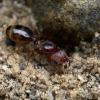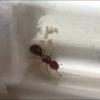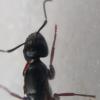Ok, she is about a quarter of an inch, maybe a little smaller. So like 6 millimeters or something like that.
And if they aren't bicarinata or pilifera, then what species are they.
We never doubted they were bicar or plifera, just that from the given pictures they are indistinguishable and therefore as you suggested, calling them pheidole sp. is appropriate atm. Now, if you have any way to take a better quality picture of the queen/major, we can give them a certain ID. These do look like bicarinata due to the majors profile, and the fact they were nesting under a rock (plifera tend make extremely deep nests) but again, no surefire way to ID from an orange blob.
In addition to getting better pictures, queen size can also determine an ID. Bicar are much smaller/thinner (usually around 5-6ish mm), while pilifera are larger and bulkier (7ish mm, some of the big girls surpassing 8mm). The real difference between them is the width,
(photo courtesy of Otter)





















